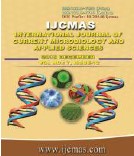


 National Academy of Agricultural Sciences (NAAS)
National Academy of Agricultural Sciences (NAAS)

|
PRINT ISSN : 2319-7692
Online ISSN : 2319-7706 Issues : 12 per year Publisher : Excellent Publishers Email : editorijcmas@gmail.com / submit@ijcmas.com Editor-in-chief: Dr.M.Prakash Index Copernicus ICV 2018: 95.39 NAAS RATING 2020: 5.38 |
Rice is the most important human food crop in the world, directly feeding more people than any other crop. India is one of the world's largest producers of rice and brown rice, accounting for 20% of all world rice production. Rice is India's pre-eminent crop, and is the staple food of the people of the eastern and southern parts of the country. The India's rice production reached to a record high of 104.32 million tonnes in 2011-2012 crop year. Thunga Bhadra Project (TBP) command area is called as ‘Rice Bowl of Karnataka’, since nearly 60-65 % of total (3.63 lakh ha) area of paddy in Karnataka is from the TBP command area (it includes the Ballari, Koppal and Raichur districts of Karnataka).The study identified there are four method of paddy residue management practices (a) Removal of straw and burning of stubbles (b) Burning of straw and stubbles (c) Removal of straw and incorporation of stubbles (d) Incorporation of straw and stubbles. It is observed that total variable cost per acre was higher in incorporation of straw and stubbles (₹ 30029.25) followed by removal of straw and burning stubbles (₹ 29345.33) and removal of straw and incorporation stubbles (₹ 29345.33), whereas lowest was recorded in burning of straw and stubbles (₹ 26616.61).In case of total cost per acre the incorporation of straw and stubbles (₹ 41845.65) was recorded highest whereas, burning of straw and stubbles (₹ 38411.33) recorded lowest. The highest yield per acre was recorded in the incorporation of straw and stubbles (29.75q/acre), followed by removal of straw and incorporation stubbles (29.15q/acre) and removal of straw and burning stubbles (28.58q/acre), whereas, burning of straw and stubbles recorded lowest yield of (28.11q/acre).
 |
 |
 |
 |
 |